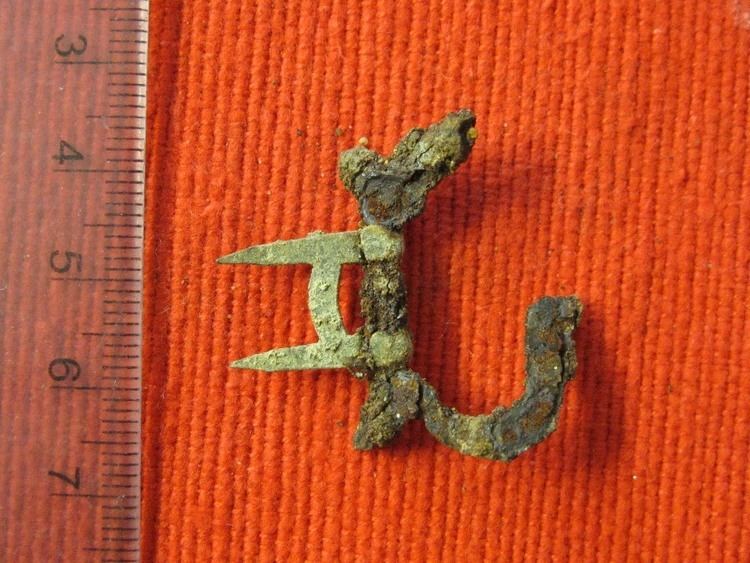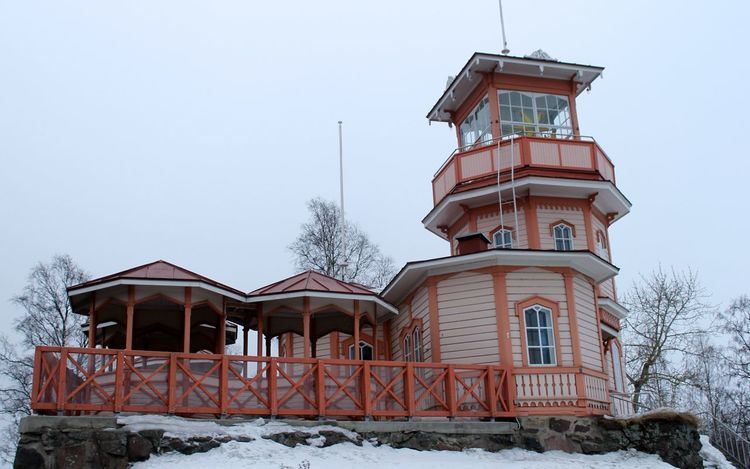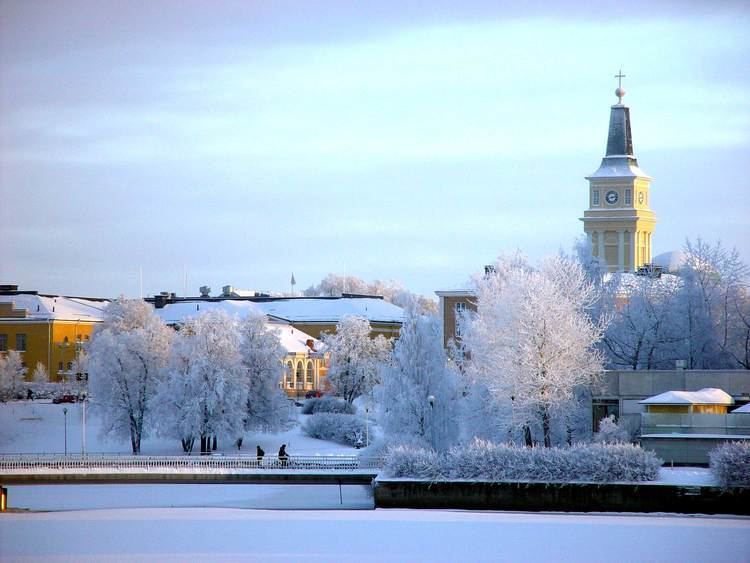Country Area 1,513.37 km2 | Language spoken Region Northern Ostrobothnia | |
 | ||
Colleges and Universities University of Oulu, Oulu University of Applied Sciences | ||
Population 7,001,170,000,000,000,000?17% | ||
Map of Oulu
Oulu ([ˈoulu]; Swedish: Uleåborg [ˌʉːleɔˈbɔrj]) is a city and municipality of 198,804 inhabitants (31 March 2016) in the region of Northern Ostrobothnia, Finland. It is the most populous city in Northern Finland and the fifth most populous city in the country. There are no larger cities, apart from Murmansk, Russia, that are more northerly than Oulu. It is also considered one of Europe's "living labs", where residents experiment with new technology (such as NFC tags and ubi-screens) at a community-wide scale.
Contents
- Map of Oulu
- Oulu syte 100 bike
- White frozen winter oulu january 2010
- Etymology
- History
- Subdivisions
- Climate
- Demographics
- Culture
- Churches
- Other points of interest
- Education
- Transport
- Employment
- Sports
- Notable people from Oulu
- Twin towns and sister cities
- Partnership and twinning cities
- International municipal projects
- References

Oulu & syöte 100% bike
White frozen winter oulu january 2010
Etymology
The city is named after the river Oulujoki, which originates in the lake Oulujärvi. There have been a number of other theories for the origin of the name Oulu. One possible source for the name Oulu is a word in the Sami language meaning 'flood water', but there are other suggestions. At minimum, the structure of the word requires that, if originally given by speakers of a Uralic language, the name must be a derivative. In all likelihood, it also predates Finnish settlement and is thus a loanword from one of the now-extinct Saami languages once spoken in the area.

The most probable theory is that the name derives from the Finnish dialectal word oulu, meaning "floodwater", which is related to e.g. Southern Sami åulo, meaning "melted snow", åulot meaning "thaw" (of unknown ultimate origin). Two other word families have also been speculated to be related. The first is seen in the Northern Savo dialectal word uula and its Sami counterpart oalli, both meaning "river channel". The second is the Uralic root reconstructed as *uwa, meaning "river bed" (reflected as vuo in modern Finnish, also in derivatives such as vuolas "heavy-flowing"). To either of these roots, some Sami variety would have to be assumed having added further derivational suffixes.
History

Oulu was founded on April 8, 1605, by King Charles IX of Sweden, opposite the fort built on the island of Linnansaari. This took place after favourable peace settlements with Russia, which removed the threat of attack via the main east-west waterway, the river Oulu. The surrounding areas were populated much earlier. Oulu is situated by the Gulf of Bothnia, at the mouth of river Oulujoki, which is an ancient trading site. Oulu was the capital of the Province of Oulu from 1776 to 2009.
In 1822, a major fire destroyed much of the city. The architect Carl Ludvig Engel, chiefly known for the neoclassical (empire style) buildings around Helsinki Senate Square, was enlisted to provide the plan for the rebuilding of the city. With minor changes, this plan remains the basis for the layout of Oulu's town center. The Oulu Cathedral was built in 1832 to his designs, with the spire being finished in 1844. During the Crimean War, Oulu's harbour was raided by the British fleet, destroying ships and burning tar houses, leading to international criticism.
Once known for wood tar and salmon, Oulu has evolved into a major high-tech centre, particularly in IT and wellness technology. Other prominent industries include wood refining, chemicals, pharmaceuticals, paper, and steel.
The municipality of Ylikiiminki was merged with the city of Oulu on January 1, 2009. Oulu and the municipalities of Haukipudas, Kiiminki, Oulunsalo, and Yli-Ii were merged on January 1, 2013.
Subdivisions
Oulu is divided into 106 city districts. The largest of these are Haukipudas, Oulunsalo, Kaakkuri, Ritaharju, Tuira, and Kello.
Climate
Oulu has a subarctic climate Dfc with cold, snowy winters and short, warm summers. Average annual temperature is 2.7 °C (36.9 °F). The average annual precipitation is 477 mm (18.78 in) falling 105 days per year, mostly in late summer and fall.
Demographics
In 2008, there were 316 Swedish speaking inhabitants, which was 0.2% of the total population, making the city unilingual. In 2007, there were 2,417 foreign citizens living in the city, of whom 618 were from elsewhere in the EU. 51.1% of the population is female.
Culture
The best known cultural exports of the city of Oulu are Air Guitar World Championships, Mieskuoro Huutajat (also known as Screaming Men), and the now defunct metal band Sentenced.
Many artists, writers, and musicians live in the city. A variety of concerts—rock, classical, and jazz—as well as other cultural events take place each year. Examples include the Oulu Music Video Festival, the Air Guitar World Championships, and the Musixine Music Film Competition, all in August. In July, the annual rock festival Qstock takes place. The Oulu Music Festival is held in winter and the Oulunsalo Music Festival in summer. The Irish Festival of Oulu takes place each October and the International Children's Film Festival each November.
Museums in Oulu include the Northern Ostrobothnia museum, the Oulu Museum of Art (OMA), the Tietomaa science center, and the Turkansaari open-air museum.
Notable statues and sculptures in Oulu include a sculpture of Frans Michael Franzén and The Bobby at the Market Place statue.
Kalmah is a melodic death metal-band from Oulu that formed in 1998.
Churches
Other points of interest
Education
The University of Oulu and Oulu University of Applied Sciences have their main campuses located in Oulu.
Oulu is home to the most northerly architecture school in the world. The school is best known for its strong regionalistic ideas for developing architecture. This movement is named "the Oulu school" ("Oulun koulu") of architecture.
Oulu Vocational College has over 13 000 students. It houses several different study subjects in different units which are spread over Oulu and neighbouring municipalities. Oulu Vocational College School of Business Studies is one of the few vocational schools which has game programming in its curriculum.
Oulu International School is one of nine schools in Finland offering basic education in English.
Transport
Oulu is served by Oulu Airport, the second largest airport in Finland by passenger volume. It is located 15 kilometres (9 mi) south-west of the city centre.
The Port of Oulu is one of the busiest harbours on the Bothnian Bay. It includes four separate harbour areas: Vihreäsaari oil and bulk docks, Nuottasaari docks and Oritkari docks.
The shortest travel time from Oulu railway station to Helsinki Central railway station is 5 h 29 min, operated by VR. Other destinations include Kolari, Rovaniemi, Seinäjoki and Tampere.
The most important road in Oulu is Highway 4 (E8/E75) that runs from Helsinki to Utsjoki via Lahti, Jyväskylä, Oulu, Kemi and Rovaniemi. Other highways running to and from Oulu are Highway 20 to Kuusamo and Highway 22 to Kajaani.
Oulu is notable for its transportation network dedicated to non-vehicular traffic including pedestrians and bicycles (termed "light" traffic in Finland). In 2010, the city contained more than 600 kilometres (370 mi) of pathways and more than 100 underpasses and bridges devoted exclusively to light traffic. The network is used year-round. The ratio of light traffic pathways to residents is the highest in Finland and the cycling mode share is 20 percent. Oulu is often touted as an excellent city for bicycling.
In 2015, a large underground parking facility Kivisydän (Heart of Stone) opened in the city center directly beneath main shopping streets. The network of parallel roads for cars and pedestrians was drilled in the rock at the depth of 30 meters. The parking facility includes two ramps, 900 visitor parking lots (expandable to 1500), six access points to the ground served by 19 elevators (expandable to nine and 25), a service facility for commercial delivery vehicles, and ubi-screens which guide the driver to the selected ground access point and help locate the parked car by its license number.
Employment
As of December 31, 2008, the active working population was employed as follows:
In 2011, the most important employers were:
Sports
Ice hockey is the most popular spectator sport in Oulu. The local club Kärpät have won the SM-liiga championship title seven times (1981, 2004, 2005, 2007, 2008, 2014 and 2015). They have also been the runner-up in the IIHF European Champions Cup twice, in 2005 and 2006.
In football AC Oulu is playing in Ykkönen, the second tier of Finnish league system. Up to date only OPS have claimed Finnish football championship by winning Mestaruussarja twice in 1979 and 1980. Other notable football clubs include OLS, OTP and Tervarit.
Oulu has one well known bandy club. OLS which plays in Bandyliiga and has become Finnish champions 14 times, last in 2014. The other one, OPS, with their 7 championships, and a bronze medal as late as in 2009, announced closing down the bandy team after the 2009-10 season. In 2001 the city was the main venue for the Bandy World Championship.
Oulu is also home to several other sports clubs such as Oulu Northern Lights (American football), Oulun NMKY (Basketball), Oulun Lippo (Pesäpallo), Oulun Pyrintö (Track and field), OYUS (Rugby union), Oulu Irish Elks (Gaelic Football) and ETTA (Volleyball).
Oulun Tervahiihto is an annual ski marathon event, held since 1889.
Terwa Run & Marathon is an annual running event, held since 1989, in late May.
Notable people from Oulu
Twin towns and sister cities
Oulu is twinned with:
Partnership and twinning cities
In addition Oulu has eight 'Partnership & Twinning cities':
International municipal projects
The educational department takes part in Lifelong Learning Programme 2007–2013 in Finland.
